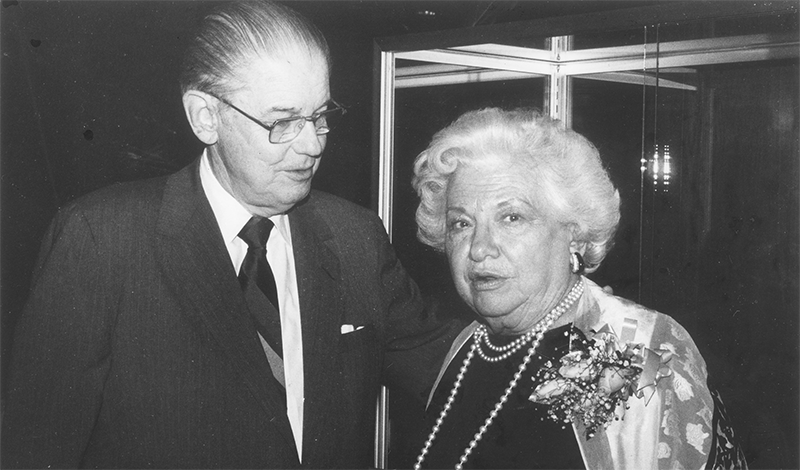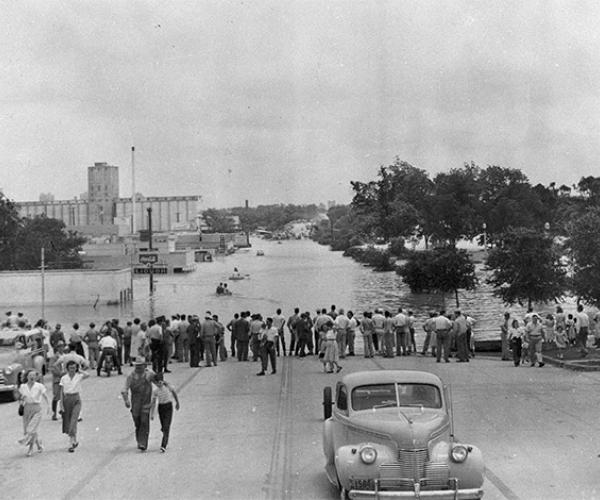History of the Friends
The Friends of the UTA Libraries: A Creation Story
--By Gerald Saxon, Associate Professor of History and former Dean of UTA Libraries
I have been asked to write a brief article about the creation of the Friends of the University of Texas at Arlington Libraries. Well, looking back nearly thirty years is a challenge, even though I study history all the time. The difference here is that I am not normally a part of the story. This time I am, at least in part, because I was there at the founding of the Friends and helped to get the group started.

In 1987 Liz Carpenter (with Jenkins Garrett) was the first speaker for the inaugural season of the Friends of the Libraries.
But I’m getting ahead of myself. The impetus for the Friends came from Charles Lowry, former director of libraries at UTA. When Lowry came to Arlington in July 1985 to lead the library, he brought with him the idea of developing a support organization for the library. When I joined the library staff in October 1986 as assistant director for Special Collections, one of the first responsibilities Lowry gave me was to coordinate the efforts on campus and with the community to start a friends group. In short, I was supposed to kick-start the group, and Lowry wanted it done in a year.
On November 16, 1986, UTA President Wendell Nedderman and his wife Betty hosted a reception on the sixth floor of the Central Library. The reception had a few purposes: first, to welcome Lowry and me to campus; second, to formally open a major exhibit that had been mounted in Special Collections titled “Mejico y Tejas: A Cartographic History, 1513-1850”; and third, to have Decherd Turner, then director of the Humanities Research Center at UT Austin, talk about library friends’ organizations in general. More than two hundred people attended the reception, prompting Lowry to announce that there would be a campaign the next year to form a friends group for UTA. The gauntlet had been thrown—publically!
In the spring of 1987, Lowry and I met with Elizabeth Leatherwood and others in the university’s Development Office to explore the creation of a support organization. Leatherwood was excited about the prospect and promised to identify individuals in the community who would share this interest and be willing to help. President Nedderman and Bill Baker, vice president for academic affairs, lent their support to the idea as well. True to her word, Leatherwood organized an interim advisory board for the organization. The first advisory board consisted of longtime supporters of the library, UTA alums, and community leaders. The group included James Cribbs, Elizabeth Fagerstrom, Margaret Galloway, Jenkins and Virginia Garrett, Bob McFarland, Connie Meyer, Cheryl Moore, Mary Perry, Cherry Rainone, Dessa Spidle, Richard Stevens, Gloria Van Zandt, John Walker, and Jane Yarbrough. Charles Harrell, associate director of libraries, Lowry, and I were the library liaisons to the board.
In short order, the board, called the Friends of the UTA Libraries Advisory Council, elected Van Zandt, a leading local realtor, as president, and Spidle as vice president. Under Van Zandt’s leadership, the Council adopted a set of bylaws, approved a membership program, prepared and distributed brochures about the Friends organization (an interesting note: current Friends’ Advisory Council member, Carol Lehman, designed the first brochure and many that followed!), and planned the first public program.
Knowing how important the first program would be in attracting an audience and hopefully the membership core for the organization, a great deal of effort went into its planning. After much discussion, the board decided to invite Liz Carpenter to be the Friends’ first speaker. Carpenter was the ideal choice. She was a popular journalist and a great speaker; she had a high profile, having been Lady Bird Johnson’s press secretary in the LBJ White House; she had a new book to promote (Getting Better All the Time); and, as a member of the Robertson family of Salado, she had UTA ties, since the Robertson papers were housed in the library’s Special Collections and her first cousin, Malcolm D. McLean, was a staff member compiling and editing the papers for publication. (another interesting note: McLean’s Papers Concerning Robertson’s Colony in Texas series includes nineteen volumes and is the most voluminous publication about a single topic in Texas history!)
On October 30, 1987, the Friends sponsored Carpenter’s talk, selling tickets to the event. More than two hundred people attended the program and the reception and autograph party that followed. Ninety copies of her book were sold that night and the Friends group received good press coverage. The Friends followed up with a number of other programs that first year, including a talk by internationally known book dealer John H. Jenkins on December 11, 1987; a presentation about maps and the myths some of them advance by Dennis Reinhartz of the University’s history faculty on April 15, 1988; and a book talk and autograph party by author and radio personality Alex Burton on June 3, 1988.
Based largely on the positive response of the community to the programs and the hard work of the Advisory Council in soliciting members, Friends membership grew that first year to 242, far exceeding our expectations. Now, looking back, it is hard to imagine that nearly thirty years have gone by since Charles Lowry initiated the idea on the UTA campus. Many of the initial leaders and members are no longer with us, but I am sure they would take pride in having created an organization that has impacted the library and its services in so many different ways.
